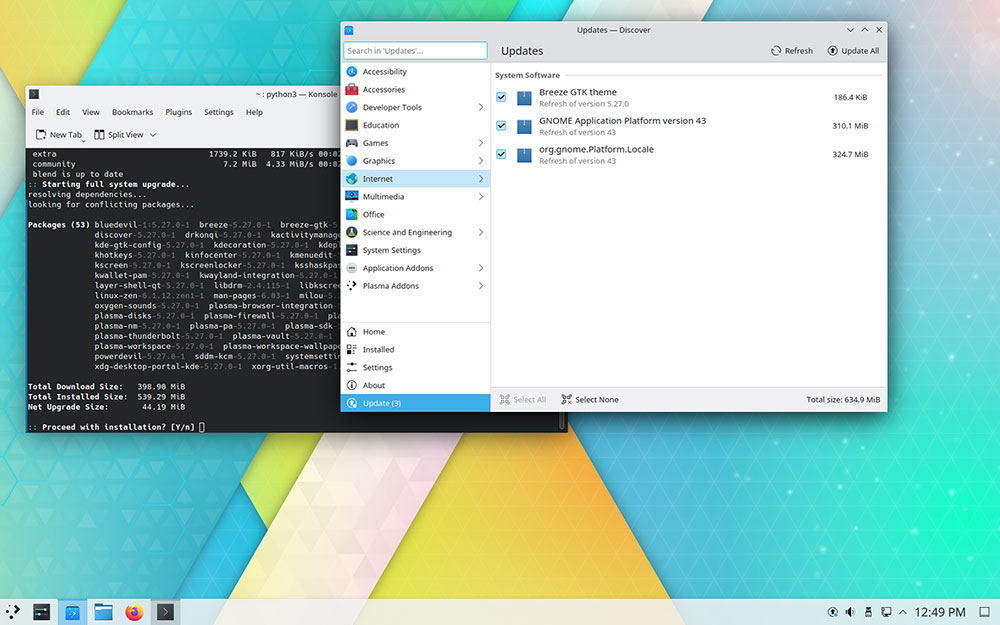During my two dozen years of writing about open source and reviewing hundreds of Linux distributions, I have developed a keen interest in Linux offerings that break out of the traditional Linux operating system molds. More often than not, the most interesting and innovative Linux versions are in a growing category of independent distros.
Two examples are relatively new Linux distributions that come with much potential. Both Carbon and Blend Linux are unique in what their developers represent.
Over the years, I have used and extensively reviewed many Linux distros developed by large companies, vast volunteer communities, and single developers. Often, the most interesting come from independent or unaffiliated Linux builders.
These include distros such as PCLinuxOS, Tiny Core Linux, Slackware Linux, 4MLinux, KaOS, Linux From Scratch, Solus, MakuluLinux, and NixOS. One of my all-time favorites is Puppy Linux and a group of close cousin distros that embellish its look and feel.
My latest hunt for promising new distros fell upon two rather special younger projects. My quest also revealed a trend among developers and users over shifting allegiances among these distribution categories.
BlendOS, as its name implies, blends software packages from other Linux projects. It brings even more flexibility by offering a choice of either the Gnome or KDE desktops.
CarbonOS, while not built on established base code from other Linux families, uses the Gnome desktop environment for familiarity and has a failure-proof upgrade and maintenance system.
Meeting Overlapping Purposes
I was recently browsing developmental news about Linux distributions when I stumbled upon a report issued by research firm Evans Data published in September 2020. Its findings showed that non-commercial or free Linux distributions were, at that point, more widely used by software developers than commercial Linux distributions.
For clarity, commercial Linux products come with a fee for user support. Bundled non-open-source licensed applications or drivers can give business users an edge over extensive in-house IT operations.
On the contrary, a community of volunteers develops non-commercial or free Linux distributions and distributes them as non-commercial products. For those reasons, this Linux category is also referred to as community-based Linux.
Surprising Linux Distro Statistics
Independent Linux distributions, a quietly growing third category, often appeal to users drawn from both categories. Independent distros are developed and maintained without using established code bases of a larger Linux project.
Hence, the description “built from scratch” fits quite well. Developers build their independent distributions using unique tool sets, coding libraries, and software packages they create or modify themselves.
According to the Evans Data report, 20 percent of developers did not think commercial Linux versions offered advantages over non-commercial versions. The study found that most developers felt that non-commercial Linux distros’ most significant advantages were ease of use and a lower cost of maintenance and upgrades.
A key advantage for independent distribution developers is the freedom to modify existing code to meet specific needs and preferences. Independent distributions have no coding dependency on base Linux distributions like Ubuntu, Fedora, Arch Linux, SUSE, and Red Hat.
Let’s take a look at these two independent Linux projects. BlendOS is much further along the developmental path, and it is suitable for even relatively new users, while seasoned Linux users might find it a refreshing alternative. CarbonOS, however, while an innovative concept in its infancy, is not yet a good choice for regular use by novice or experienced Linux users.
BlendOS Overview
This Linux distro’s developer, Rudra Saraswat, released version 2, codenamed “Avial,” on April 22 with more elements from other computing options blended into the original mix. Apps were already available in containers, and now users can directly install Arch Linux software from system depots as well as the Arch community AUR repos.
Saraswat describes himself as a 13-year-old tech nerd. Do not let his tender age deter you from trying his Blend approach to using Linux.
He maintains a home lab and uses Ubuntu and Arch. He is also an official Ubuntu Linux member and the creator and project leader of Ubuntu Unity, a remix distro of Ubuntu featuring the Unity7 desktop environment. Unity was the default desktop environment Ubuntu used from 2010 to 2017.
BlendOS offers veteran Linux users a refreshing alternative to traditional distros. It is also a suitable option for Linux newcomers.
BlendOS, in this latest edition, automatically shows applications and binaries installed in containers on the base system from a range of distributions. To prevent the potential for conflicts, Saraswat developed a new priority-based system that allows users to control which container’s binaries and apps should be given preference.
Version 2 follows a flavor and remix system where remixes are community-developed variants of blendOS. Users can easily select from the official blendOS build webpage to create and submit their own blendOS remix.
Blending Includes Android Too
This new Linux distro supports Android apps out-of-the-box using Waydroid installation. The Waydroid project is an open-source container-based solution for running the complete Android operating system inside your Linux box.
This process is similar to Google’s built-in Android app support in Chromebooks. However, rather than fuss with the official Google Play Store, the installer supports downloads from the Aurora Store and F-Droid.
The installed Android apps behave just like native, windowed Linux apps, which is useful for Android developers, as they can test their apps through Waydroid in Android Studio, just like regular Linux apps without needing a heavy Android emulator, offered the developer in his release notes.
You can install or use web apps and Progressive Web Apps (PWAs) just like regular desktop apps. Users can also submit their own web apps to the blendOS web store. An overlay system lets you install system packages using the pacman package manager as you would on a standard Arch installation.
A feature I like a lot is the ability to roll back to existing snapshots if anything goes wrong. Saraswat plans to add support for merging the overlay with the main root file system.
BlendOS is based on Arch Linux, but it is not an official Arch distro. You can use any app from any Linux distro or operating system it supports. That feature is a work in progress.
This distro turned four years old in December. It has much to offer and is well on the way to bringing more modern approaches to Linux computing.
CarbonOS Highlights
Adrian Vovk recently released an early development build of carbonOS, a general-purpose Linux operating system. Its key development selling point in this very new Linux distro is the secure user experience.
The carbonOS design is minimal and intuitive. It is built around an internal system-wide file-searching mechanism and control center that performs tasks without opening apps.
Like blendOS, its updating process makes upgrade glitches non-existent. The system updates in the background and applies the changes with a computer reboot. Should a mishap occur, carbonOS automatically undoes the troubled updates. You can also do that reversal process yourself.
Also, unlike most other Linux distributions, this one adds a nearly impenetrable security layer that blocks potentially malicious programs by making all system files read-only. Even apps you install are more secure and run in isolated sandboxes.
Vovk says his new Linux distro is a rarity for another important reason. It uses OSTree, making it only one of three distros to do so. The other two are Endless OS and Fedora Silverblue.

The carbonOS desktop is a paradigm of simplicity and efficiency.
The OSTree Advantage
OSTree is a system for versioning updates of Linux-based operating systems. It operates in user space and works on top of any Linux file system.
As Vovk explains the process, the operating system exists in a git repository. The /usr directory is read-only.
The entire system state exists in the /home, /var, and /etc directories. Clearing out just those three locations ensures a return to a stock state.
Rebooting and then selecting the previous version at the bootloader rolls back the system. This process is simple and very similar to how Chromebooks upgrade.
The upgrade process is much less complicated than is used in most other Linux distros. The updates involve much smaller downloads because only binary differences from the previous version of carbonOS are needed. No full-package downloading happens.
Vovk plans to remove the complexities built into typical Linux systems. Stock carbonOS is simplified to manage the hardware, run Flatpak apps, and not get in your way, he stated.
CarbonOS is currently in a very early alpha release. So trying it now is for testing purposes only — but it is definitely a Linux distro to keep in mind as the development matures.
Suggest a Review
Is there a Linux software application or distro you’d like to suggest for review? Something you love or would like to get to know?
Email your ideas to me, and I’ll consider them for a future column.
And use the Reader Comments feature below to provide your input!


























































Yet beware of small independent Distros as your main machine. Early on I used the original Solus, which I loved, but the developer shut it down overnight leaving me without a Distro. Then I tried Point Linux, a Debian based Distro that made Debian everything it could be and should be for the average user, but the developer decided he had to much other stuff to do until the Distro withered and died.
I now stick to well larger, well funded, multi developer Distros. I do have an older laptop I can still play with smaller independent Distros, but they will never again be my go to machine.